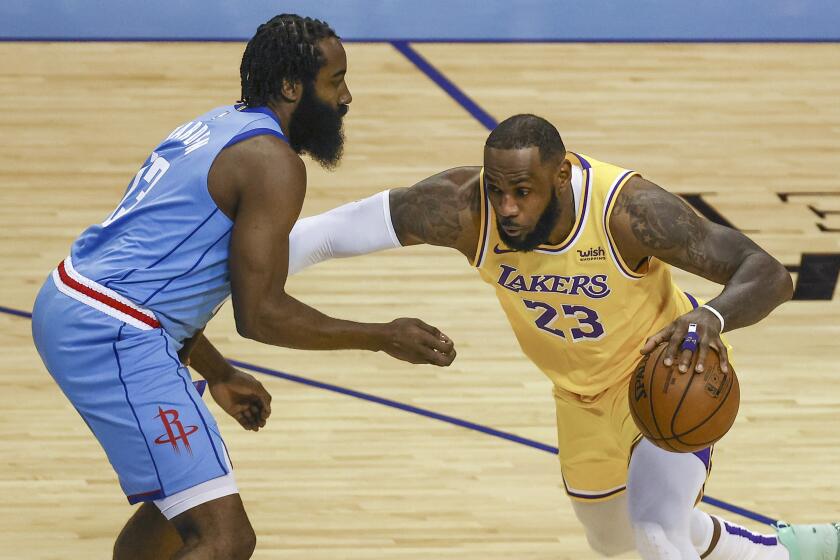POWER SHORTAGE : A 45-Homer Season Has Become a Rarity, So 60 Appears to Be an Unreachable Goal
- Share via
Newspapers have long since ceased running those optimistic midsummer charts comparing Kevin Mitchell’s homer pace with Babe Ruth’s and Roger Maris’. Mitchell, who had 31 home runs at the All-Star break, won’t hit 60. He might not even hit 50; only a recent surge--six homers in 17 games--has moved Mitchell within reach of that plateau.
Actually, nobody hits 50 anymore. For all the talk of a juiced-up baseball, only once in the last 20 seasons has anyone hit 50: George Foster, 52, in 1977. Sluggers have become an endangered species.
Forget 50, hardly anyone surpasses 45 homers anymore. Although it happened 14 times in the 1960s, it has happened only 10 times during the 1970s and 1980s combined; and an explosion--three of the 10: Mark McGwire’s 49, George Bell’s 47 and Andre Dawson’s 47--happened in 1987, when the ball was so loaded it would’ve failed a steroid test.
Why should 45-plus be so rare? Ruth did it nine times. You want to discount Ruth because he played 60 years ago? Fine, but Harmon Killebrew managed it four times, Willie Mays three, Mickey Mantle and Eddie Mathews twice each--that’s one baseball generation ago.
What changed in the ‘70s and ‘80s?
Ballparks, for one thing. New ones were constructed to be spacious and symmetrical. No more pennant porches. No more 256 down the line. It’s harder to jerk one out when your outfield wall is a toll call away.
Artificial turf, for another. Speed-friendly surfaces influenced managements to de-emphasize power, especially in newer parks, where slugging is discouraged by design. Kansas City and St. Louis are archetypal examples of successful Turf Teams that deliberately offer less bang for the buck.
The most obvious change was the specialization of pitchers. Even dominating long-haul starters such as Mike Scott, Dwight Gooden, Bret Saberhagen and Roger Clemens routinely make way for closers. Relief pitching has become as important as starting pitching; with certain innovative managers, such as Whitey Herzog, it may be more important.
It goes without saying that everyone wants a closer, but middle relievers and the more recent category of subspecialists, the set-up men, have become essential. Take the Orioles. Gregg Olson surely is the key pitcher, but where would the Orioles be without versatile Mark Williamson? Specialization is the cultural revolution in pitching over the last 20 years.
“You’re seeing fresh pitchers all the time,” baseball analyst Tim McCarver said. “They pitch for one or two overpowering outs, then leave. Specialization has made it very difficult to hit home runs. Teams used to have four starters, two of whom you’d pay to hit against--that’s where home-run hitters fattened up. Now you may see a different pitcher every time up.”
Another reason you don’t see 50 homers, why First-Half Phenoms cool down in the second halves, is because managers simply won’t let those hitters beat them anymore--it’s too embarrassing; it looks like the manager is too dumb to learn a lesson. So Mitchell has 32 intentional walks. “Managers dig their heels in,” McCarver observed. “They’ll say: ‘Screw him. Walk him.’ ”
Clearly, the odds are stacked against someone hitting 50. You need to be in a situation conducive to seeing good pitches. Mitchell benefits from Will Clark being on base in front of him so often. McGwire benefits from Jose Canseco. Don Mattingly’s home runs are down this season, in part because he isn’t surrounded by threatening hitters; he no longer has Rickey Henderson hitting ahead of him, or Jack Clark and Dave Winfield hitting behind him.
But McCarver says there’s another, more subtle, reason why home-run hitters are evaporating. “Too many young hitters haven’t any idea where the strike zone is,” McCarver said. “Pitchers can literally pitch around them. They don’t have to give them anything good because the hitters don’t demand it. Darryl Strawberry is an example of a guy who doesn’t know the strike zone. He’s unable to get pitchers to come to him. They’ll throw bad pitches, and he’ll chase them. Young hitters have to learn that although it sounds like an oxymoron: If you take more pitches, you’ll get more pitches to hit.”
McCarver, however, doesn’t hold out much hope that young sluggers will heed this lesson. He doesn’t see their incentive to stop swinging away. “The guiding force behind everything seems to be that you have to hit homers to make money,” he said ruefully. “That’s how big contracts are negotiated--over home runs, not walks. So hitters are up there whaling away. They may even be encouraged to do so by their agents. These kids can’t grasp the long-term benefit in being more selective.”
In this regard the young sluggers are victims of the societal urge toward immediate gratification. This acquisitive mind-set is baseball’s version of the yuppie. They’ve locked themselves into their bad habits by locking themselves into instantaneous results. Hitting is a knowable craft, but it takes time to learn. Wade Boggs and Tony Gwynn are examples of patient, studious hitters. In McCarver’s view many young sluggers seem unwilling to apprentice themselves to the task. They want it all, and they want it now; they’ve absorbed the swagger values of beer commercials. They don’t want to take pitches because they’re uncomfortable conceding a strike. They don’t know how to set up a pitcher. And it doesn’t occur to them that they ought to learn.
The pitchers aren’t necessarily ahead of the hitters, they’re just smarter.
More to Read
Go beyond the scoreboard
Get the latest on L.A.'s teams in the daily Sports Report newsletter.
You may occasionally receive promotional content from the Los Angeles Times.










